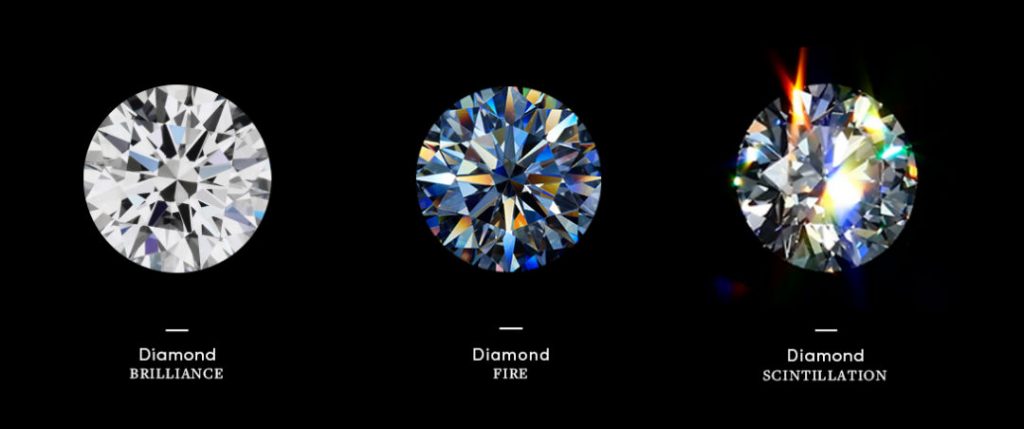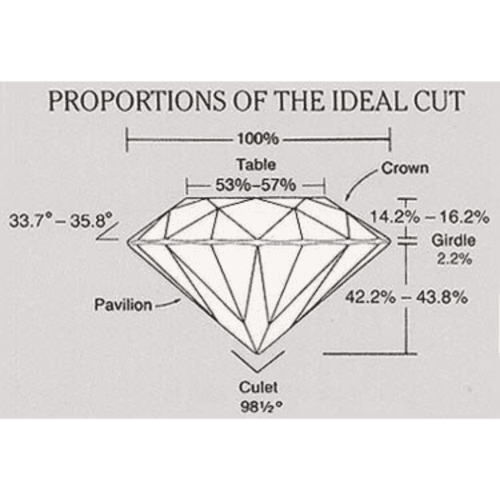What Makes a Diamond Sparkle—and How Do You Find the Best One?
Is there anything more captivating than a sparkling diamond? I guess that really depends who you ask, but we know to never underestimate the power of a well-cut diamond. Whether it’s in an engagement ring, a pair of diamond stud earrings, or a solitaire pendant, it’s sure to draw some attention.
So why do some diamonds sparkle more than others? What creates the sparkle within a diamond? And how can you make sure that the diamond you purchase sparkles brilliantly? All of these questions may feel overwhelming, but we promise, the answers are easy to understand, and they’re a combination of nature, art, and science.
Many people believe that the sparkle of a diamond is due to its clarity, but this isn’t necessarily true. Of course, a diamond with a higher clarity grade is also more likely to have great sparkle, but one doesn’t depend upon the other.
The sparkle of a diamond is actually affected by how the light interacts with the stone’s facets, and mostly depends upon the cut of the diamond.
Sparkle can be broken up into three different optical effects:
- Brilliance
- Fire
- Scintillation
Once you understand how they all work individually and together, you’ll know exactly what to look for when you’re diamond shopping.
Breaking Down Brilliance, Fire, and Scintillation
Let’s first start by understanding the difference between the three main optical effects that make a diamond sparkle.
Brilliance is the white light that gets returned to your eye from both the surface and interior of the diamond. Brilliance is the optical effect that makes a diamond look bright and shiny.
Fire is the color flash that you see when a diamond is moved around under a direct light source. Fire happens when the light disperses into the colors of the spectrum (think ROYGBIV) like a prism.
Scintillation refers to the light and dark flashes that you see when the diamond moves–which makes the diamond look more alive. It is said that the contrast between the light and dark is what makes the diamond elicit more sparkle.
When all three of these optical elements are combined together, your eye is able to see a diamond sparkle. However, without the diamond having the right cut, sparkle is impossible.

How Diamond Cut Affects Sparkle
Diamonds come out of the earth (or the lab) looking dirty, dull, and freeform in shape. They look nothing like they do on your engagement ring. It takes quite a bit of work–from a talented diamond cutter–to get them from their raw state to their final state of sparkling beauty.
Diamond cutters have to evaluate a diamond from all angles to determine how to get the best looking stone with the diamond rough that they have. They must evaluate it not only for size, but also for the best way to cut the stone to hide the inclusions and make the shape as symmetrical as possible for the best light return. Every partial millimeter makes a difference in the diamond cut.
The first priority is to maximize light return through the top of the stone, making sure the diamond can sparkle. The cutter then needs to do calculations to make sure the proportions will be perfect for the angles of each facet.
Diamond cutters need to consider each of the following:
- Table size, which is the large, flat facet on the top of the diamond. This affects how the light can enter and exit the stone.
- Crown angle, which is the angle between the table and the girdle (the widest part of the diamond).
- Pavilion angle, which is from the girdle to the point at the bottom (the culet).
- Total depth of the diamond, so it is balanced to allow for optimal light performance.

If even one of these is slightly off, the sparkle of the diamond will not be ideal.
Sparkle of the Round Brilliant Cut Diamond
The round brilliant cut is the most popular diamond shape–and for good reason. Its development began with early shapes like the Old Mine Cut, Single Cut, Old European Cut, and Transition Cut. These cuts were reflective of the cutting techniques and technologies available at the time.
In 1919, Belgian mathematician Marcel Tolkowsky introduced the modern round brilliant cut. He developed it using math to determine the ideal proportions and facets that would maximize brilliance, fire, and scintillation, thus creating the perfect sparkling diamond.
This cut typically has 57 or 58 facets, which are precisely arranged to optimize light reflection. Approximately 70% of all diamonds sold today are round brilliant cut. Their popularity is due to their light performance and timelessness.
Round brilliant cut diamonds have a cut grading scale from "Excellent" to "Poor". This grading information is listed on diamond grading certificates, specifically from The Gemological Institute of America (GIA). Other diamond grading labs have their own cut grading scale, but the GIA scale is the most universally accepted.
Other Factors That Affect a Diamond’s Sparkle
While cut is the most important factor affecting the brilliance of a diamond, there are other aspects that make a difference:
- Color has a more subtle effect on sparkle because colorless diamonds allow more light to pass through and reflect, whereas stones that fall lower on the color scale have less brilliance due to less light returning to the eye.
- Clarity also affects brilliance because inclusions can block light from passing through the stone. The more inclusions in a diamond, the less light that can return to the eye.
Should you purchase a diamond online?
It's possible to find a decent diamond online. That said, it may not be the ideal way to purchase a diamond. When you shop for a diamond online, you won't be able to move the diamond around in different light sources to see how it sparkles.
If you're dead set on buying a diamond online try to choose websites that provide videos of the stones, so you can get a better idea of what it looks like from multiple angles. It's still not the same as examining a diamond in person, however.
It’s also important to consider the supporting aspects of the stone–color, clarity, and carat weight– because they will have an effect on the sparkle, if even in a small way.
Choosing a Diamond That Truly Sparkles
When you’re shopping for a diamond, the most important aspect you should consider for maximum sparkle is cut. Make sure to select a stone that has an "Excellent" or "Very Good" cut grade, especially when it comes to round brilliant cut diamonds.
Diamonds don’t just come out of the ground sparkling beautifully. They are cut and polished meticulously with calculations and talent by a gem cutter. When the diamond is cut just right, the brilliance, fire, and scintillation all come together to create the perfect sparkle that will wow anyone looking in the direction of that diamond.
The truth is, most diamonds end up being a symbol of love and commitment that you’ll cherish for a long time to come. It doesn’t hurt if your symbol of love and commitment also happens to be the sparkliest one you’ve ever seen, does it?

